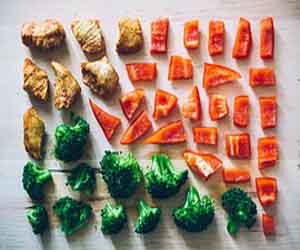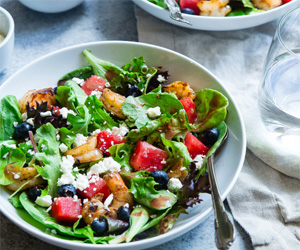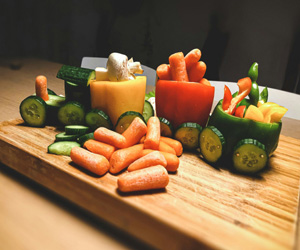


The Art Of Ingredient Substitutions

In the world of cooking, there are times when you may find yourself in a pinch, missing a key ingredient for your recipe. This is where the art of ingredient substitutions comes into play, allowing you to adapt and experiment while still creating delicious dishes. Whether you're dealing with dietary restrictions, food allergies, or simply an empty pantry, mastering ingredient substitutions is a valuable skill for any home cook.
Why Ingredient Substitutions Matter
Ingredient substitutions are a creative solution to common cooking challenges. They empower you to overcome limitations, adapt to dietary preferences, and make the most of what you have in your kitchen. They can be particularly useful in emergencies when you don't have time to run to the store or want to reduce food waste.
Common Ingredient Substitutions
Buttermilk: When a recipe calls for buttermilk and you don't have any on hand, you can make a substitute by adding 1 tablespoon of white vinegar or lemon juice to 1 cup of milk and letting it sit for a few minutes.
Egg: To replace an egg in baking, you can use ingredients like applesauce, mashed bananas, yogurt, or silken tofu, depending on the desired texture.
All-Purpose Flour: If you're out of all-purpose flour and need a substitute for baking, you can use alternatives like almond flour, coconut flour, or oat flour, depending on the recipe.
Sugar: For a healthier alternative, you can replace refined sugar with options like honey, maple syrup, or coconut sugar.
Butter: When a recipe calls for butter, you can use alternatives like coconut oil, olive oil, or unsweetened applesauce, depending on the application.
Heavy Cream: To replace heavy cream in savory dishes, you can use ingredients like Greek yogurt, silken tofu, or a mixture of milk and butter. For desserts, coconut cream can be a suitable alternative.
Healthier Ingredient Substitutions
Ingredient substitutions aren't just about convenience; they can also be used to make your dishes healthier. For example:
White Rice: Swap white rice for brown rice, quinoa, or cauliflower rice to increase fiber content and boost nutritional value.
Mayonnaise: In salads and sandwiches, you can replace mayonnaise with Greek yogurt for a lower-fat alternative.
Breadcrumbs: Instead of breadcrumbs, you can use crushed nuts or rolled oats for a gluten-free option in recipes.
Dietary Restrictions And Allergies
Ingredient substitutions are especially crucial for individuals with dietary restrictions and allergies. For those with gluten allergies, there are many gluten-free flours and starches available. People with lactose intolerance can use lactose-free milk or dairy-free alternatives. Those with nut allergies can often substitute seeds, such as sunflower or pumpkin seeds, for nuts in recipes.
Culinary Creativity
Ingredient substitutions also open the door to culinary creativity. They encourage you to experiment, develop new flavors, and adapt recipes to suit your personal preferences. For instance, you can use different spices and herbs to create unique flavor profiles, or you can substitute vegetables or proteins to put your own twist on classic dishes.
The art of ingredient substitutions is a valuable tool in the kitchen. It empowers you to adapt to various cooking challenges, make healthier choices, and cater to dietary restrictions and allergies. It also encourages culinary creativity and experimentation. With a little practice and an understanding of ingredient characteristics, you can confidently navigate your kitchen and create flavorful dishes, even when you're missing a key ingredient.
Essential Tips For Success
 2. Start With Whole Foods
2. Start With Whole Foods
The foundation of a gluten-free lifestyle is natural, unprocessed foods. Fresh fruits and vegetables, lean proteins, and unprocessed grains like rice and quinoa are naturally gluten-free. These foods should form the basis of your diet, providing you with essential nutrients and fiber.
3. Experiment With Gluten-Free Alternatives
There's a wide variety of gluten-free alternatives available for the bread, pasta, and baked goods you love. Try different gluten-free flours, such as rice, almond, and coconut flour, in your recipes. Experiment with gluten-free pasta made from corn, rice, or quinoa. Over time, you'll discover which products and brands you prefer.
4. Beware Of Cross-Contamination
Cross-contamination is a significant concern for people with celiac disease. Even trace amounts of gluten can trigger symptoms or damage the small intestine. To prevent cross-contamination, create a designated gluten-free area in your kitchen.
Sip Your Way To Health And Vitality
 One of the primary benefits of nutrient-dense refreshments is their ability to deliver a substantial dose of vitamins and minerals. For instance, green smoothies loaded with leafy greens like spinach and kale provide essential vitamins such as A, C, and K, along with minerals like potassium and magnesium. These nutrients play a pivotal role in supporting your immune system, promoting healthy skin, and maintaining proper muscle and nerve function.
One of the primary benefits of nutrient-dense refreshments is their ability to deliver a substantial dose of vitamins and minerals. For instance, green smoothies loaded with leafy greens like spinach and kale provide essential vitamins such as A, C, and K, along with minerals like potassium and magnesium. These nutrients play a pivotal role in supporting your immune system, promoting healthy skin, and maintaining proper muscle and nerve function.
Antioxidant-Rich Elixir
Antioxidants are like the superheroes of the nutrition world, defending your body against free radicals and oxidative stress. Nutrient-dense refreshments are often teeming with antioxidants derived from fruits, vegetables, and superfoods like berries, beets, and turmeric.
Elevate Your Culinary Game With Clever Shortcuts
 4. Efficiency: Cooking hacks streamline the cooking process, making it more efficient. They allow you to multitask, so you're not chained to the stove, and they minimize the number of pots and pans you need to wash.
4. Efficiency: Cooking hacks streamline the cooking process, making it more efficient. They allow you to multitask, so you're not chained to the stove, and they minimize the number of pots and pans you need to wash.
5. Creativity: Hacks encourage experimentation and creativity in the kitchen. They open up new possibilities and inspire you to try new techniques and flavors.
Must-Know Cooking Hacks
Here are a few essential cooking hacks that can make your time in the kitchen more efficient and enjoyable:
1. Knife Skills: Mastering basic knife skills can save time and improve your safety in the kitchen. Learn to chop, dice, and slice like a pro to speed up meal prep.
2. Use Citrus Zest: The zest of citrus fruits like lemons and oranges is a flavor powerhouse. Grate the outer skin for a burst of aroma and taste in your dishes.
Techniques For Delicious, Safe Meals
 Separate Utensils: Use separate cutting boards, knives, and kitchen equipment for gluten-free cooking to avoid cross-contamination.
Separate Utensils: Use separate cutting boards, knives, and kitchen equipment for gluten-free cooking to avoid cross-contamination.
Clean Thoroughly: Ensure that surfaces and equipment are thoroughly cleaned before use. This includes cleaning countertops, oven racks, and utensils.
Label Ingredients: Clearly label gluten-free ingredients to prevent mix-ups, especially if you store gluten-containing and gluten-free products together.
Binding And Texture: Enhancing Your Dishes
Gluten provides structure and texture in many recipes. To mimic these qualities in gluten-free cooking:
Use Binders: Incorporate binding agents like xanthan gum or ground flaxseed mixed with water into recipes to improve the texture of baked goods.
A Delicious Journey Back To The Source
 Support For Local Farmers: Farm-to-table dining supports local farmers and strengthens the regional economy. Local farmers are often small-scale, family-owned businesses, and by purchasing their produce, consumers help maintain the livelihood of these farmers.
Support For Local Farmers: Farm-to-table dining supports local farmers and strengthens the regional economy. Local farmers are often small-scale, family-owned businesses, and by purchasing their produce, consumers help maintain the livelihood of these farmers.
Sustainability: The farm-to-table movement champions sustainability in agriculture. Farmers who engage in this practice tend to use eco-friendly, responsible farming methods that prioritize soil health, reduce the use of harmful chemicals, and minimize carbon emissions associated with food transportation.
Community Connection: Farm-to-table restaurants often foster a strong sense of community. Diners have the opportunity to meet the people responsible for growing their food, forging meaningful connections between producers and consumers. Farmers' markets and community-supported agriculture programs further strengthen these connections.
Elevating Your Culinary Experience
 Time Efficiency: One of the most significant benefits of simplified cooking is the time it saves. By using shortcuts, pre-prepped ingredients, and easy-to-follow recipes, you can have a tasty meal on the table in no time. This is particularly valuable for busy individuals and families with packed schedules.
Time Efficiency: One of the most significant benefits of simplified cooking is the time it saves. By using shortcuts, pre-prepped ingredients, and easy-to-follow recipes, you can have a tasty meal on the table in no time. This is particularly valuable for busy individuals and families with packed schedules.
Minimal Ingredients: Simplified cooking often relies on a shorter list of ingredients. You don't need a pantry full of exotic spices and specialty items. Instead, you can create flavorful dishes with basic staples, reducing both cost and clutter in your kitchen.
Easy Cleanup: With fewer pots, pans, and utensils involved, cleanup becomes a breeze. Many simplified recipes are designed for one-pot cooking, reducing the time spent on dishwashing and kitchen tidying.
Versatility: Simplified cooking doesn't mean boring or repetitive meals. With some creativity, you can adapt simple recipes to your tastes by adding or substituting ingredients. This flexibility encourages experimentation and the discovery of new favorite dishes.
Health Benefits: Many simplified cooking techniques emphasize fresh, whole ingredients. You'll have better control over what goes into your meals, making it easier to create nutritious options that fit your dietary preferences.